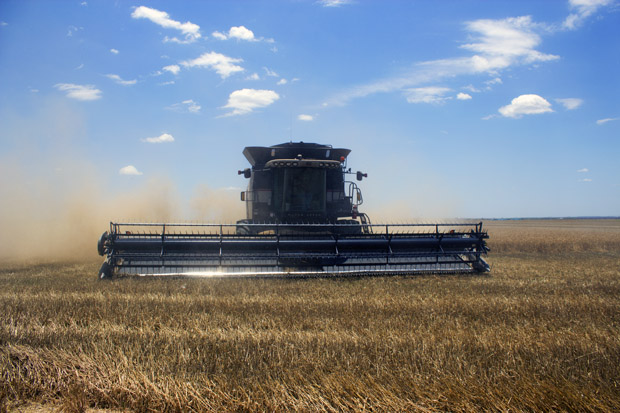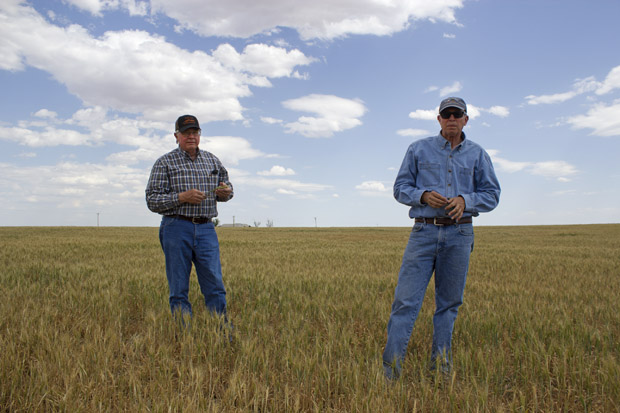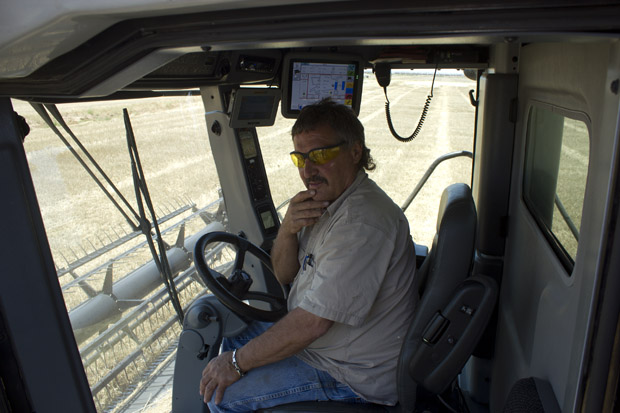
A combine crew from South Dakota harvests wheat near Altus in southwest Oklahoma.
Joe Wertz / StateImpact Oklahoma


A combine crew from South Dakota harvests wheat near Altus in southwest Oklahoma.
Joe Wertz / StateImpact Oklahoma

Joe Wertz / StateImpact Oklahoma
A combine crew from South Dakota harvests wheat near Altus in southwest Oklahoma.
May 2015 was Oklahoma’s wettest month on record. The historic rainfall washed away an economically draining drought that haunted parts of the state for five years. For many wheat farmers in southwestern Oklahoma, however, the record rainfall is too much, too late.
To find a farmer in the wide, unbroken prairie of southwest Oklahoma, scan the horizon and look for clouds — of dust. In a field five miles south of Altus, Fred Schmedt peers through the haze and watches a gray-and-black combine pull alongside a tractor with a grain cart.
Schmedt grins as the bin fills.
“We’re really tickled to death,” he says.
That’s because the test weight of the Ruby Lee wheat harvested in the field is coming in at 61.7 pounds per bushel — great news for Schmedt’s bottom line.
Last year, the family-run farm had fields that yielded fewer than 8 pounds per bushel. Statewide, Oklahoma wheat farmers averaged 17 pounds per bushel in 2014, data from the U.S. Department of Agriculture show — the result of one of the state’s worst harvests on record.
“This is the best field of wheat we’ve cut so far,” Schmedt says.
The bad news: The harvests at the Schmedt family’s other fields haven’t been this good. Slow-moving storms and favorable climate patterns dumped record amounts of rainfall across Oklahoma in April and May. The rain broke the drought, but it came too late for many wheat farmers.
“It would have been much better on the wheat crop if it would have come a month earlier,” he says. “But, here again, we’re glad to get what we got.”

Joe Wertz / StateImpact Oklahoma
Brothers and business partners Fred and Wayne Schmedt stand in their family's wheat field near Altus in southwest Oklahoma.
StateImpact interviewed Schmedt last year during that awful 2014 wheat harvest. At the time, Schmedt and his brother and business partner, Wayne, were worried they wouldn’t have a job for their cutter. Craig Wolf has traveled from South Dakota to Oklahoma for decades to help the Schmedt family cut its wheat.
“He’s cut our families’ wheat since 1973,” Fred Schmedt said in May 2014. “He sort of needs a job.”
The Schmedts had a job for Wolf again this year. Wolf, in turn, was able to hire four other workers — two Bulgarians and two South Africans.

Joe Wertz / StateImpact Oklahoma
Craig Wolf, a custom cutter from South Dakota, travels to Oklahoma every year to harvest the Schmedt family's wheat.
“They’re pretty good guys,” says Wolf from the driver’s seat of his Gleaner S7 combine. “They’re doing good.”
The cab of the combine is air-conditioned and comfy, which seems strange because we’re only a few feet and a piece of glass away from a terrifying, whirling blade. This machine is operated with a joystick and a flat-screen and guided by satellites.
Wolf thinks this year’s wheat harvest will be better than last year’s, but the weather that broke Oklahoma’s drought did a lot of damage. “A blessing and a curse,” says Schmedt, who lost many fields to hail damage. “Others were too soggy for combines and other heavy harvesting equipment.”
“The rains came; they came a little late. It was more or less a salvage operation,” says Jeff Edwards, a small grains extension specialist at Oklahoma State University.
This year, Oklahoma’s wheat crop was ready before the fields were dry, Edwards says. Soggy, unharvested fields can mean rotting wheat, rampant weeds and early sprouting — problems that cost money and time, and result in lower yields, he says.
“It’s better than last year, but it’s not going to go down as what we’d term a ‘good year,’” Edwards says.
Wheat is Oklahoma’s No. 1 cash crop. In one of those “good years,” the state’s crop is valued at $650 million. A good year also means 140 million bushels statewide. In 2014, Oklahoma harvested about one-third of that — 47 million bushels, USDA data show. Edwards is hoping for 100 million bushels this year.
Fred Schmedt hopes that next year, the rain will start in February instead of April. But, like other Oklahoma farmers, he’s adapting. This field is about to change.
“This afternoon it will be planted back to cotton,” he says.
The timing of this year’s historic rains weren’t ideal for wheat, but this field is irrigated. The once-dried-up ponds, lakes and reservoirs are full. That means at least some Oklahoma farmers can turn on the tap instead of waiting on the weather.